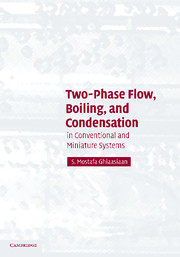Book contents
- Frontmatter
- Contents
- Preface
- Frequently Used Notation
- TWO-PHASE FLOW, BOILING AND CONDENSATION IN CONVENTIONAL AND MINIATURE SYSTEMS
- PART ONE TWO-PHASE FLOW
- PART TWO BOILING AND CONDENSATION
- 11 Pool Boiling
- 12 Flow Boiling
- 13 Critical Heat Flux and Post-CHF Heat Transfer in Flow Boiling
- 14 Flow Boiling and CHF in Small Passages
- 15 Fundamentals of Condensation
- 16 Internal-Flow Condensation and Condensation on Liquid Jets and Droplets
- 17 Choking in Two-Phase Flow
- APPENDIX A Thermodynamic Properties of Saturated Water and Steam
- APPENDIX B Transport Properties of Saturated Water and Steam
- APPENDIX C Thermodynamic Properties of Saturated Liquid and Vapor for Selected Refrigerants
- APPENDIX D Properties of Selected Ideal Gases at 1 Atmosphere
- APPENDIX E Binary Diffusion Coefficients of Selected Gases in Air at 1 Atmosphere
- APPENDIX F Henry's Constant of Dilute Aqueous Solutions of Selected Substances at Moderate Pressures
- APPENDIX G Diffusion Coefficients of Selected Substances in Water at Infinite Dilution at 25°C
- APPENDIX H Lennard–Jones Potential Model Constants for Selected Molecules
- APPENDIX I Collision Integrates for the Lennard–Jones Potential Model
- APPENDIX J Physical Constants
- APPENDIX K Unit Conversions
- References
- Index
13 - Critical Heat Flux and Post-CHF Heat Transfer in Flow Boiling
- Frontmatter
- Contents
- Preface
- Frequently Used Notation
- TWO-PHASE FLOW, BOILING AND CONDENSATION IN CONVENTIONAL AND MINIATURE SYSTEMS
- PART ONE TWO-PHASE FLOW
- PART TWO BOILING AND CONDENSATION
- 11 Pool Boiling
- 12 Flow Boiling
- 13 Critical Heat Flux and Post-CHF Heat Transfer in Flow Boiling
- 14 Flow Boiling and CHF in Small Passages
- 15 Fundamentals of Condensation
- 16 Internal-Flow Condensation and Condensation on Liquid Jets and Droplets
- 17 Choking in Two-Phase Flow
- APPENDIX A Thermodynamic Properties of Saturated Water and Steam
- APPENDIX B Transport Properties of Saturated Water and Steam
- APPENDIX C Thermodynamic Properties of Saturated Liquid and Vapor for Selected Refrigerants
- APPENDIX D Properties of Selected Ideal Gases at 1 Atmosphere
- APPENDIX E Binary Diffusion Coefficients of Selected Gases in Air at 1 Atmosphere
- APPENDIX F Henry's Constant of Dilute Aqueous Solutions of Selected Substances at Moderate Pressures
- APPENDIX G Diffusion Coefficients of Selected Substances in Water at Infinite Dilution at 25°C
- APPENDIX H Lennard–Jones Potential Model Constants for Selected Molecules
- APPENDIX I Collision Integrates for the Lennard–Jones Potential Model
- APPENDIX J Physical Constants
- APPENDIX K Unit Conversions
- References
- Index
Summary
Critical Heat Flux Mechanisms
Critical heat flux is the most important threshold in forced-flow boiling. Forced-flow CHF is equivalent to peak heat flux in pool boiling and represents the upper limit for the safe operation of many cooling systems that rely on boiling heat transfer. The occurrence of CHF can cause a large temperature rise at the heated surface, potentially leading to its physical burnout. Moreover, the post-CHF heat transfer regimes are inefficient. Depending on circumstances, CHF is also referred to as boiling crisis, departure from nucleate boiling, dryout heat flux, and burnout heat flux. Processes leading to forced-flow CHF are very complicated, involving the coupling of heat transfer, phase change, and two-phase flow hydrodynamics phenomena.
Consider the CHF line depicted in Fig. 13.1 which displays a portion of the boiling map previously shown in Figs. 12.4 and 12.5. Horizontal lines in this figure show qualitatively the sequence of heat transfer regimes encountered along a uniformly heated channel in steady state. Thus, moving along a horizontal line from left to right is similar to moving along a boiling channel. As noticed in the figure, depending on the heat flux, CHF can occur under subcooled or saturated boiling conditions. When CHF takes place in subcooled boiling or saturated boiling at low flow qualities, the process is called departure from nucleate boiling (see Section 12.1), a title that is descriptive of the mechanism involved.
- Type
- Chapter
- Information
- Two-Phase Flow, Boiling, and CondensationIn Conventional and Miniature Systems, pp. 371 - 404Publisher: Cambridge University PressPrint publication year: 2007



